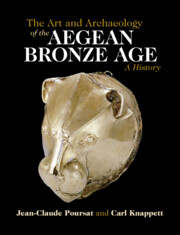Book contents
- The Art and Archaeology of the Aegean Bronze Age
- The Art and Archaeology of the Aegean Bronze Age
- Copyright page
- Contents
- Figures
- Introduction
- Part I Aegean Neolithic Art
- Part II The Art of the Aegean Early Bronze Age
- Chapter 6 Artefacts and Contexts
- Chapter 7 Architecture
- Chapter 8 Early Bronze Age Aegean Glyptic
- Chapter 9 Sculpture
- Chapter 10 Stone Vases, Metalware, and Miscellaneous
- Chapter 11 Early Bronze Age Pottery in the Aegean
- Part III Aegean Art in the Cretan First Palace Period
- Part IV Aegean Art in the Second Palace Period
- Part V Aegean Art in the Cretan Second Palace Period
- Part VI Aegean Art in the Final Palatial Period of Knossos
- Part VII Aegean Art of the Mainland Mycenaean Palatial Period
- Part VIII Aegean Art at the End of the Bronze Age
- Afterword Aegean Art Through Forgers’ Eyes
- References
- Index
- Plate Section (PDF Only)
- References
Chapter 8 - Early Bronze Age Aegean Glyptic
from Part II - The Art of the Aegean Early Bronze Age
Published online by Cambridge University Press: 19 May 2022
- The Art and Archaeology of the Aegean Bronze Age
- The Art and Archaeology of the Aegean Bronze Age
- Copyright page
- Contents
- Figures
- Introduction
- Part I Aegean Neolithic Art
- Part II The Art of the Aegean Early Bronze Age
- Chapter 6 Artefacts and Contexts
- Chapter 7 Architecture
- Chapter 8 Early Bronze Age Aegean Glyptic
- Chapter 9 Sculpture
- Chapter 10 Stone Vases, Metalware, and Miscellaneous
- Chapter 11 Early Bronze Age Pottery in the Aegean
- Part III Aegean Art in the Cretan First Palace Period
- Part IV Aegean Art in the Second Palace Period
- Part V Aegean Art in the Cretan Second Palace Period
- Part VI Aegean Art in the Final Palatial Period of Knossos
- Part VII Aegean Art of the Mainland Mycenaean Palatial Period
- Part VIII Aegean Art at the End of the Bronze Age
- Afterword Aegean Art Through Forgers’ Eyes
- References
- Index
- Plate Section (PDF Only)
- References
Summary
Alongside cylinder and stamp seals designed for impressing decorative motifs into large jars or hearth rims, true seals – that is, those for imprinting signs into clay sealings – now make an appearance. Early Bronze Age (EBA) glyptic is best known from the sealings accidentally fired in the destructions at the end of Early Bronze (EB) II, as found, for example, in buildings such as the House of the Tiles at Lerna. Such sealings were pressed against the lids of jars and on the openings of chests or doors in order to regulate the movement of commodities of various kinds. The mark of the seal allowed for the identification of the individual responsible for the goods in question. Once the sealing was broken in the process of accessing the contents secured inside, it was then kept as an archival record of the transaction.
- Type
- Chapter
- Information
- The Art and Archaeology of the Aegean Bronze AgeA History, pp. 46 - 50Publisher: Cambridge University PressPrint publication year: 2022

